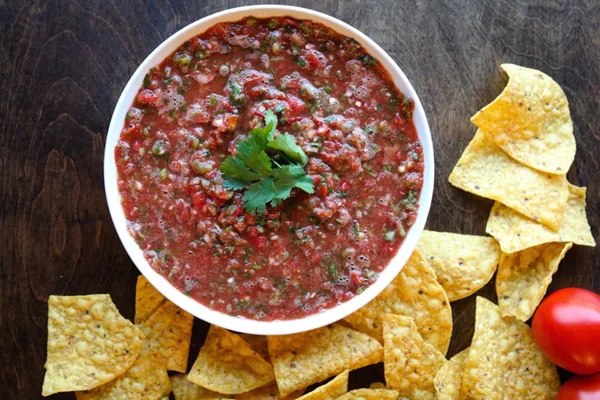Uncle Julio’s Salsa Recipe is a delicious, easy-to-make dip that is great for all occasions. It is supposed to be served with tortilla chips or by itself.
This recipe is so simple and easy to make that you will want to make it over and over again.
This is a great salsa recipe that you can use year-round. It goes well with chips, which is great for parties, tailgates, and more.
You can add green onions, jalapenos, cabbage, or tomato to make it even more flavorful. You can whip it up in just minutes! So get ready to start the party with this simple salsa recipe.
Uncle Julio’s Salsa Recipe
Prepare Time: 10 minutes
Cook Time: 30 minutes
Yield: 10 servings
Recipe Ingredients
- 5 large tomatoes
- 3 small tomatillos
- 1 jalapeno
- 1/2 red onion, sliced
- 1 large clove of garlic, peeled
- 1/4 cup cilantro, finely chopped
- 3tablespoons fresh lime juice
- 3 tablespoons vegetable oil
- Sea salt and freshly cracked pepper to taste
Step By Step Instructions
Step-1: Rinse tomatoes, tomatillos, and jalapeno. Slice lengthwise and remove seeds.
Step-2: Heat vegetable oil in a large skillet over medium heat. Add the chopped onion, minced garlic, tomatillos, and jalapenos; sauté until soft, about 2 minutes. Now add the tomato slices and simmer for about 5 minutes.
Step-3: Add lime juice, season with salt and pepper to taste, and simmer for another 5 minutes. Remove from heat and transfer to a food processor or blender; puree until smooth. Transfer to a serving bowl; garnish with chopped cilantro and serve immediately or refrigerate until chilled before serving.
Nutrition Facts Per Serving
| Nutrition | Amount |
|---|---|
| Calories | 88 |
| Total Fat | 7 g |
| Sodium | 2 mg |
| Carbohydrates | 6 g |
| Fiber | 2g |
Excellent Source Of: Vitamin A, Vitamin C, Calcium, Iron, and Riboflavin.
How Should I Serve Salsa?
Salsa is served as an accompaniment to tortilla chips. Other condiments, such as guacamole and sour cream, can be added to enhance the flavor. In addition to serving with chips, salsa is also ideal for making burritos and nachos.
Are Salsa Good For You?
Yes! Salsa is very nutritious and a good source of Vitamins A and C, calcium, iron, and riboflavin. It’s also rich in folic acid (a B vitamin). There aren’t any calories or fat in salsa, which makes it a guilt-free way to enjoy Mexican cuisine. Just be sure to go easy on the chips.
They are loaded with carbs and fried in vegetable oil — two things that aren’t so good for you. The best way to enjoy salsa is to use only a little bit of it and substitute healthier chips.

5 Health Benefits Of Salsa
1. Promotes Healthy Cholesterol
Salsa is packed with fiber, which helps lower cholesterol levels in the body. Fiber also helps move food through the digestive system smoothly and keeps digestion regular. This can help prevent constipation, hemorrhoids, and other gastrointestinal problems.
2. Lowers Cancer Risk
Vitamin A is key to promoting good vision and preventing macular degeneration of the eyes, which is a leading cause of blindness among older adults.
Vitamin A may also be helpful in preventing some types of cancer, namely lung cancer and cervical cancer in women.
3. Promotes Heart Health
Salsa is a good source of fiber, which helps keep your heart healthy by keeping the digestive system regular. Studies have shown that the fiber in salsa and other vegetables helps to prevent heart attack and stroke by lowering blood cholesterol levels.
4. Aids Type 2 Diabetes
Diabetes is an epidemic today, and many obesity-related health problems are linked to diabetes, including obesity and depression.
Some research also suggests that a diet high in vegetables may help prevent type 2 diabetes risk factors such as excess body weight and high blood sugar levels.
5. Promotes Weight Loss
Although the calories in salsa are moderate, fresh salsa can be high in sodium. People with hypertension or those with pre-existing high blood pressure should avoid dishes that are high in sodium.
A medium serving of salsa has about 350 mg of sodium, the same as a cup of milk. For those who drink a lot of milk or have to deal with fluid retention due to weight, it’s best to avoid eating too much salsa.
Can Salsa Be Frozen?
Yes! Because salsa is a puree that contains no fat or sugar, it can be frozen for later use. Just freeze the salsa in an airtight container and bring it back to room temperature before serving.
How To Reheat The Salsa?
Salsa can be heated in a frying pan or a microwave oven. Just be sure to leave plenty of room between the crushed chips to prevent scorching.
Conclusion
Salsa is a healthy and delicious way to enjoy Mexican cuisine. Have fun replacing rich sauces with this low-calorie dip for an easy, guilt-free meal.
As always, make sure you’re enjoying your dishes in moderation to keep your weight under control.
- Jet’s Ranch Recipe: Make The Famous Dip At Home - April 12, 2025
- James Hemings Macaroni And Cheese Recipe – History On A Plate - April 3, 2025
- French Dip Squares Recipe – Better Than A Sandwich! - March 25, 2025